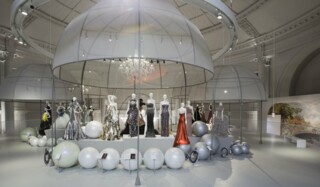At the V&A
Fatema Ahmed
Last month Seth Siegelaub gave a tour of The Stuff that Matters, an exhibition at the Raven Row gallery devoted to his collection of rare books about textiles and some rare fabrics too. ‘The history of textiles,’ he said as we looked at his Renaissance damasks and silks laid flat in display cases, ‘is the history of the wealthy... and the history of those objects which are the least used.’ He was also clear-eyed about the nature of collecting. It’s important to him that his library is properly catalogued and freely available but, he added, ‘it would be a stretch to say that everything I do, I do it for humanity blah, blah, blah.’ Sometimes, Siegelaub said, ‘collecting is just hoarding.’
You'd expect a certain level of wry self-awareness from someone who ‘left the art world and moved to Paris’ where, in the 1970s, he set up as a Marxist publisher, putting out an anthology of Marx and Engels’s writings about art and the first English translation of Ariel Dorfman and Armand Mattelart’s How to Read Donald Duck: Imperialist Ideology in the Disney Comic.
A sense of self-awareness is sadly missing from Ballgowns: British Glamour since 1950, the first exhibition in the V&A’s redesigned fashion galleries. Many of the dresses were donated by their creators, or by benefactors for whom they were made. Ballgowns is an unpleasurable show; I didn’t realise how accurate the title would be, or how the exhibition’s focus on the adjective in the subtitle would undercut the noun.
The dimly lit downstairs display space is filled with ballgowns from the museum’s permanent collection. The House of Worth is everywhere, and although Charles Worth is generally recognised as the father of haute couture, by the mid-20th century, the clients who commissioned dresses from his great-grandson seem to have wanted nothing more than pretty, embroidered frocks in shades of tinned salmon. There’s a lot of Norman Hartnell and an accompanying series of films with such titles as The Queen Mother Sees New Styles (1953).
Most of Ballgowns comes across as a long lament for the demise of the Season, which ended in 1958 when the presentation of debutantes at Court was abolished. ‘As society became more egalitarian,’ the display text explains, ‘the strict social parameters that the Season defined were eroded.’ The 1970s come as a relief – and, in the case of Ossie Clark’s gold leather corset and jacket on top of a purple lace full skirt, a surprise – but things take a nosedive in the 1980s as the display texts welcome the era of ‘charity balls’ and stripy, backless taffeta dresses are what the glamorous philanthropist was wearing.
There’s a real sense of escape as you climb the stairs to the mezzanine floor of the Octagon Court, which has been turned into a ‘ballroom space’: a pavilion with mannequins on podiums, surrounded by what look like white exercise balls but are apparently oversized representations of pearls. The uniformity of the dresses on display here – empire-line waists and sheath outlines dominate – and a sign that says ‘Though accepted as female attire since the 1960s, trousers are rarely worn on the red carpet’ made me long for Yves Saint Laurent and a firebomb.
It’s no surprise that the standout design is by Vivienne Westwood. In the centre of the upstairs gallery there’s a swirl of a dress that even on a mannequin looks as if it’s on the move. It's an outlandish combination of kimono-style top and a flamenco-style lower half: a black tulle skirt with a huge orange-and-yellow checked bodice punctured by a black sash pinned through it like a flake in an ice-cream cone. It’s made with imagination, wit and skill – you could wear it to please only yourself and it’s hard to think of an occasion for which it could ever be ‘appropriate’. It holds out the slim hope that ‘British glamour’ isn’t quite the oxymoron the rest of the exhibition makes it out to be.
